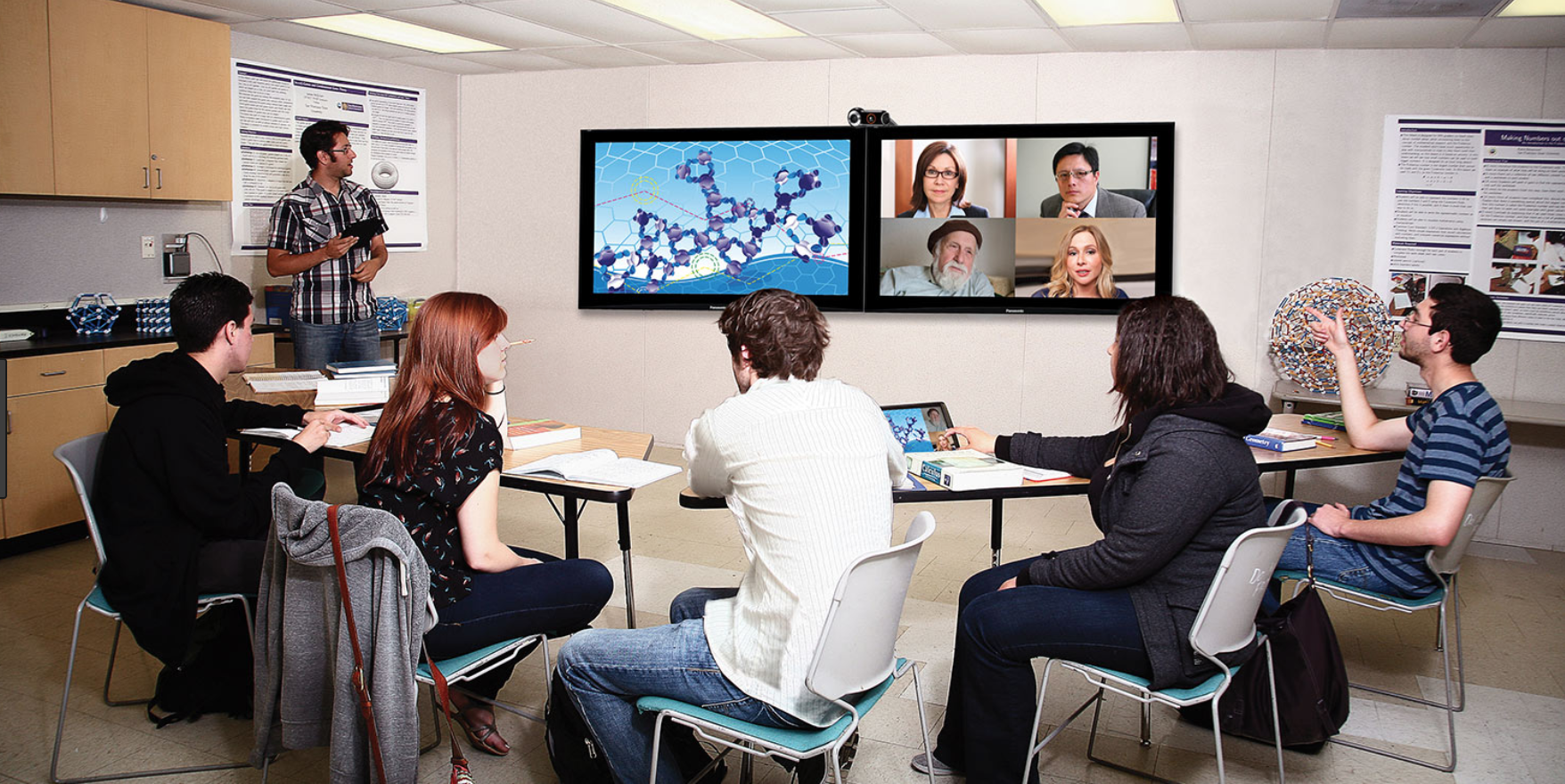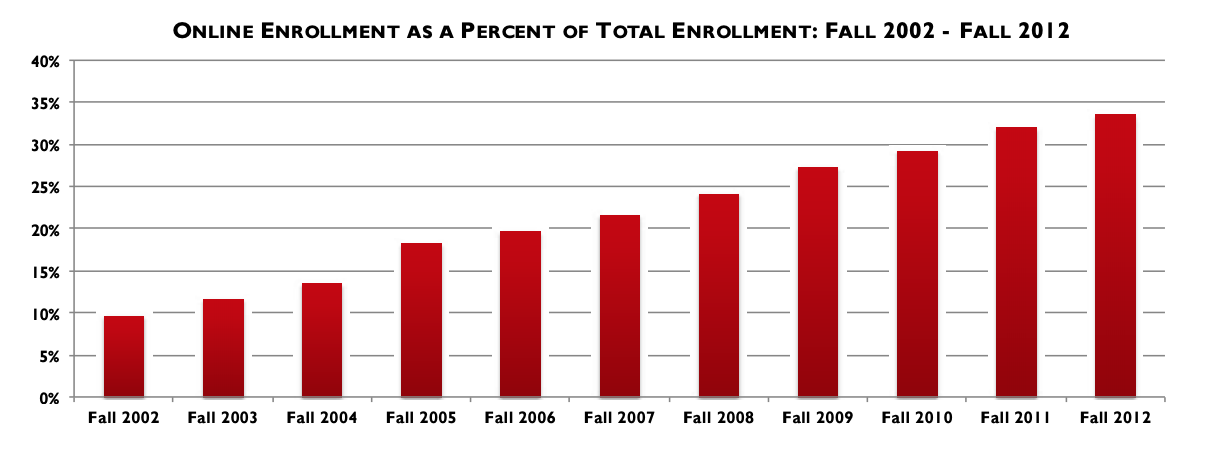Chapter 1: Fundamental Change in Education
1.7 From the periphery to the center: how technology is changing the way we teach
![]()

![]()
We shall see in Chapter 7, Section 2 that technology has played an important role in teaching from time immemorial, but until recently, it has remained more on the periphery of education. Technology has been used mainly to support regular classroom teaching, or operated in the form of distance education, for a minority of students or in specialized departments (often in continuing education or extension).
However, in the last ten to fifteen years, technology has been increasingly influencing the core teaching activities of universities and colleges. Some of the ways technology is moving from the periphery to the centre can be seen from the following trends.
1.7.1. Fully online learning
Credit-based online learning in recent years has become a major and central activity of most academic departments in universities, colleges and to some extent even in school/k-12 education.
Online learning enrolments increased by between 10-20 per cent per annum between 2002 and 2012 in North American higher education institutions, compared with an increase in campus-based enrolments of around 2-3 per cent per annum (Allen and Seaman, 2014).

![]()
In just the California Community College System alone, there are almost one million online course enrolments (Johnson and Mejia, 2014). There are now at least seven million students in the USA taking at least one fully online course, almost 30 per cent of all post-secondary students in the USA; and 14 per cent of all students are taking only distance education courses. The majority of these fully online enrolments (just over two-thirds) are in public institutions in the USA (online enrolments in for-profit institutions plunged after 2012 due to Obama-era regulation). At the same time, the number of students studying on a campus in the USA dropped by almost one million (931,317) between 2012 and 2015 (Digital Learning Compass, 2017).
The situation in Canada is somewhat similar. Most Canadian post-secondary institutions (83 per cent) offered fully online courses for credit in 2017. Roughly 17 per cent of all students were taking at least one online course; online course registrations totalled 1.3 million, accounting for eight per cent of all credit course enrolments. This is equivalent in a system with roughly 70 universities and 150 public colleges to four additional universities of 27,000 students, and five additional colleges of 10,000 students. Online learning was considered by institutional leaders to be very or extremely important for the institution’s future in over two-thirds of all institutions (Bates et al, 2018)
Thus fully online learning is now a key component of many school and post-secondary education systems.
1.7.2. Blended and hybrid learning
As more instructors have become involved in online learning, they have realised that much that has traditionally been done in class can be done equally well or better online (a theme that will be explored more in Chapter 10, Section 2). As a result, instructors have been gradually introducing more online study elements into their classroom teaching. So learning management systems may be used to store lecture notes in the form of slides or PDFs, links to online readings may be provided, or online forums for discussion may be established. Thus online learning is gradually being blended with face-to-face teaching, but without changing the basic classroom teaching model. Here online learning is being used as a supplement to traditional teaching. Although there is no standard or commonly agreed definitions in this area, I will use the term ‘blended learning’ for this use of technology.
More recently, though, lecture capture has resulted in instructors realising that if the lecture is recorded, students could view this in their own time, and then the classroom time could be used for more interactive sessions. This model has become known as the ‘flipped classroom’.
An even more significant move, but still in a minority of classes, is the move to hybrid learning, where some, but not all, of regular classroom time is replaced by online activities. This sometimes leads to a complete re-design of the teaching experience for students.
Some institutions are now developing plans to move a substantial part of their teaching into more blended or flexible modes. Almost two-thirds of the institutions in the 2017 Canadian survey either had a plan for online learning or were developing one, and another 30 per cent reported that they did not have a plan but needed one. For instance in 2013 the University of Ottawa developed a plan to have at least 20 per cent of its courses blended or hybrid within five years (University of Ottawa, 2013). The University of British Columbia has a plan to redesign most of its first and second year large lecture classes into hybrid classes. Furthermore, some instructors are incorporating emerging technologies such as simulations and educational or serious games, augmented and virtual reality, in ways that fundamentally change the experience of learning. These are all indications of the growing importance of digital learning.
1.7.3. Open learning
Another increasingly important development linked to online learning is the move to ‘open’ education that over the last 10 years has begun to impact directly on conventional institutions. The most immediate is open textbooks – such as what you are reading now. Open textbooks are digital textbooks that can be downloaded in a digital format by students (or instructors) for free, thus saving students considerable money on textbooks. For instance, in Canada, the three provinces of British Columbia, Alberta, and Saskatchewan are collaborating on the production and distribution of peer-reviewed open textbooks for the 40 high-enrolment subject areas in their university and community college programs. By 2018 nearly all post-secondary institutions in British Columbia (90 per cent) had adopted at least one open textbook (Bates et al, 2018).
Open educational resources (OER) are another recent development in open education. These are digital educational materials freely available over the Internet that can be downloaded by instructors (or students) without charge, and if necessary adapted or amended, under a Creative Commons license that provides protections for the creators of the material. Probably the best known source of OER is the Massachusetts Institute of Technology OpenCourseWare project. With individual professors’ permission, MIT has made available for free downloading over the Internet video lectures recorded with lecture capture as well as supporting materials such as slides.
The implications of developments in open learning will be discussed further in Chapter 11.
1.7.4. MOOCs
One of the main developments in online learning has been the rapid growth of Massive Open Online Courses (MOOCs). In 2008, the University of Manitoba in Canada offered the first MOOC with just over 2,000 enrolments, which linked webinar presentations and/or blog posts by experts to participants’ blogs and tweets. The courses were open to anyone and had no formal assessment. In 2012, two Stanford University professors launched a lecture-capture based MOOC on artificial intelligence, attracting more than 100,000 students, and since then MOOCs have expanded rapidly around the world.
Although the format of MOOCs can vary, in general they have the following characteristics:
- open to anyone to enroll and simple enrollment (just an e-mail address)
- very large numbers (from 1,000 to 100,000)
- free access to video-recorded lectures, often from the most elite universities in the USA (Harvard, MIT, Stanford in particular).
- computer-based assessment, usually using multiple-choice questions and immediate feedback, combined sometimes with peer assessment
- a wide range of commitment from learners: up to 50 per cent never do more than register, 25 per cent never take more than the first assignment, less than 10 per cent complete the final assessment.
However, MOOCs are merely the latest example of the rapid evolution of technology, the over-enthusiasm of early adopters, and the need for careful analysis of the strengths and weaknesses of new technologies for teaching. They are evolving over time, and are beginning to find a more limited but still important niche in the higher education market. MOOCs will be discussed more fully in Chapter 5.
1.7.5 Managing the changing landscape of education
These rapid developments in educational technologies mean that faculty and instructors need a strong framework for assessing the value of different technologies, new or existing, and for deciding how or when these technologies make sense for them and their students to use. Blended and online learning, social media and open learning are all developments that are critical for effective teaching in a digital age.
However, these emerging technological developments need to be harnessed to the changing needs of learners in a digital society, which means also looking at different ways of teaching and ensuring these teaching methods and choices of technology are fully aligned with the needs of learners in a digital age.
References
Allen, I. and Seaman, J. (2014) Grade Change: Tracking Online Learning in the United States Wellesley MA: Babson College/Sloan Foundation
Bates, T. et al. (2018) Tracking Online and Distance Education in Canadian Universities and Colleges 2018 Halifax: Canadian Digital Learning Research Association
Digital Learning Compass (2017) Distance Education Enrolment Report 2017 Wellesley MA
Johnson, H. and Mejia, M. (2014) Online learning and student outcomes in California’s community colleges San Francisco CA: Public Policy Institute of California
University of Ottawa (2013) Report of the e-Learning Working Group Ottawa ON: University of Ottawa: see also Report on the Blended Learning Initiative (2016), which reports on progress in implementing the plan
Activity 1.7 The consequences of change
- Have you in recent years moved to blended or online learning or used new technology in your teaching? If so, what was your reason?
- If not, what has stopped you trying a new approach with technology?
- If you have started to use technology in your teaching, what were the main difficulties you encountered? Did you get sufficient help from colleagues or the institution?
- Did you change your academic goals or did you try to achieve the same learning outcomes as in fully face-to-face teaching?
- Were there any unintended or unexpected consequences of moving towards the use of more technology in your teaching?
There is no feedback provided for this activity.

